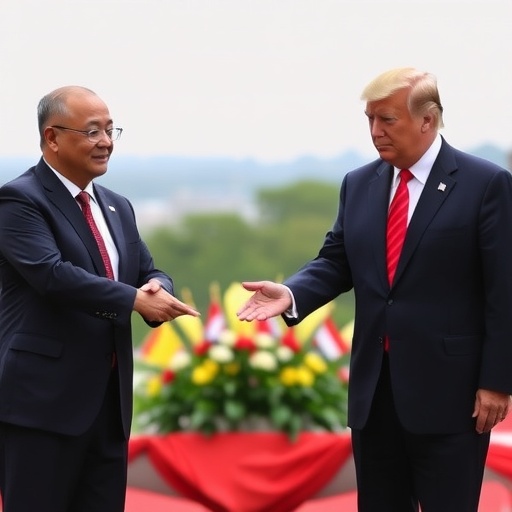Trump Strengthens US Ties in Southeast Asia at ASEAN Summit Amid Rising China Trade Tensions
In a bold move to counter China’s growing influence, President Donald Trump made a high-profile appearance at the ASEAN summit in Jakarta, Indonesia, where he inked groundbreaking economic frameworks with Cambodia, Thailand, and Malaysia. This strategic pivot underscores the US commitment to bolstering secure supply chains and fostering regional partnerships in Southeast Asia, directly responding to Beijing’s recent export restrictions on critical technologies and rare earth minerals.
The summit, attended by leaders from all 10 ASEAN member states, highlighted a shifting global trade landscape. Trump‘s engagements signal a renewed US focus on the region, which is home to over 650 million people and a rapidly growing economy projected to reach $3.6 trillion by 2025, according to the World Bank. By prioritizing these deals, the US aims to diversify its trade dependencies away from China, which has imposed stringent export controls on semiconductors and other high-tech components amid escalating US-China trade frictions.
Trump Seals Economic Pacts with Key ASEAN Nations
President Trump’s itinerary at the ASEAN summit was packed with bilateral meetings that culminated in the signing of three pivotal economic frameworks. The first agreement with Cambodia focuses on agricultural trade and infrastructure development, aiming to increase US imports of Cambodian rice and garments by 25% over the next five years. Cambodian Prime Minister Hun Manet, in a joint press conference, praised the deal as a ‘lifeline for our farmers,’ noting that it includes $500 million in US aid for modernizing irrigation systems in the Mekong Delta region.
Moving to Thailand, the framework emphasizes manufacturing and digital economy cooperation. Thailand, a hub for automotive and electronics assembly, stands to benefit from US investments totaling $1.2 billion in semiconductor fabrication plants. Thai Commerce Minister Phumtham Wechayachai highlighted the pact’s role in creating 50,000 jobs, stating, ‘This partnership with the US will help Thailand leapfrog in the global supply chain, reducing our overreliance on any single market.’
The crown jewel of Trump’s visit was the agreement with Malaysia, centered on energy security and rare earth processing. Malaysia’s vast deposits of rare earth elements make it a strategic ally against China’s dominance, which controls over 80% of global supply. The deal includes joint ventures for mining and refining, with US firms like Tesla and Apple committing to source 30% of their rare earth needs from Malaysian facilities by 2030. Malaysian Prime Minister Anwar Ibrahim remarked, ‘In an era of supply chain vulnerabilities, this US-Malaysia alliance ensures stability and innovation for both our nations.’
These pacts are not isolated; they build on the US-ASEAN Comprehensive Strategic Partnership established in 2022, which has already facilitated $15 billion in trade volume growth. Trump’s direct involvement elevates these agreements, signaling to investors that Southeast Asia is a priority arena for US economic diplomacy.
China’s Export Restrictions Spark US Regional Push
Beijing’s export restrictions, announced just weeks before the summit, have sent ripples through global markets. In response to US tariffs on Chinese electric vehicles and solar panels, China curtailed exports of gallium and germanium—key materials for chip manufacturing—causing prices to surge by 40% overnight. This move, widely seen as retaliation in the ongoing US-China trade war, has prompted companies worldwide to seek alternatives in Southeast Asia.
Trump addressed this head-on during his summit keynote, declaring, ‘America will not stand idly by as China weaponizes trade. We’re building resilient partnerships in Southeast Asia to secure our future.’ His administration’s strategy aligns with the CHIPS and Science Act, which allocates $52 billion for domestic semiconductor production but also encourages overseas diversification. Southeast Asia, with its skilled workforce and favorable trade policies, emerges as the ideal counterweight.
Statistics underscore the urgency: China’s share of global electronics exports has climbed to 35%, up from 25% a decade ago, per the International Trade Centre. In contrast, ASEAN’s intra-regional trade hit $800 billion in 2023, with the US now its third-largest partner after China and the EU. Trump’s initiatives aim to flip this dynamic, potentially redirecting $100 billion in annual trade flows away from China by enhancing US-ASEAN connectivity.
Geopolitically, this push comes amid heightened South China Sea tensions, where China’s assertive claims have strained relations with ASEAN nations like Vietnam and the Philippines. By deepening economic ties, the US is not only addressing trade imbalances but also reinforcing a rules-based order in the region.
Southeast Asia’s Economies Gear Up for US-Led Boom
The ripple effects of Trump’s deals are already palpable across Southeast Asia. In Cambodia, where exports to the US account for 40% of its total, the new framework promises to stabilize an economy battered by post-pandemic recovery challenges. Analysts from the Asian Development Bank forecast a 6% GDP uplift for Cambodia by 2026, driven by increased foreign direct investment (FDI) in agro-processing.
Thailand, Southeast Asia’s second-largest economy, sees the pacts as a catalyst for its ‘Thailand 4.0’ initiative. With US firms pledging investments in electric vehicle battery production, the country could capture 15% of the regional EV market, projected to grow to $50 billion by 2030. Local businesses, from Bangkok’s tech startups to Chiang Mai’s manufacturing clusters, are buzzing with opportunities, though experts warn of the need for workforce upskilling to meet US standards.
Malaysia’s response has been the most enthusiastic, with its stock market rising 2.5% on news of the rare earth deal. The agreement aligns with Malaysia’s National Energy Transition Roadmap, which targets net-zero emissions by 2050. By partnering with the US, Malaysia aims to process 20,000 tons of rare earth oxides annually, creating a supply chain less vulnerable to Chinese fluctuations. Environmental safeguards are baked in, including US-funded sustainable mining practices to mitigate ecological impacts in Sabah and Sarawak.
Beyond these three nations, the summit fostered broader ASEAN-wide commitments. Trump announced a $2 billion US fund for digital infrastructure, benefiting all members and addressing the digital divide that leaves 200 million Southeast Asians offline. This holistic approach positions Southeast Asia as a linchpin in global trade resilience.
Global Experts Praise Trump’s ASEAN Strategy
Reactions from trade experts and policymakers have been overwhelmingly positive, viewing Trump’s summit as a masterstroke in US foreign policy. Dr. Maria Gonzalez, senior fellow at the Brookings Institution, noted, ‘This isn’t just about trade; it’s a geopolitical chess move. By engaging ASEAN directly, Trump is peeling away layers of China’s regional monopoly.’
In Southeast Asia, think tanks echo this sentiment. The Institute of Southeast Asian Studies in Singapore released a report estimating that enhanced US ties could add $200 billion to ASEAN’s collective GDP over the next decade. However, not all voices are unanimous; some critics, like economist Lee Kuan Yew’s protégé Kishore Mahbubani, caution against over-dependence on US markets, urging ASEAN to maintain neutrality in great-power rivalries.
From Washington, Commerce Secretary Gina Raimondo lauded the deals, saying, ‘President Trump’s vision secures American jobs while empowering our partners. This is win-win diplomacy at its finest.’ Investors are taking note too: FDI inflows to ASEAN surged 12% in the summit’s aftermath, with US venture capital firms eyeing opportunities in fintech and green energy.
Challenges remain, including navigating ASEAN’s consensus-driven decision-making and addressing non-tariff barriers like regulatory harmonization. Yet, the momentum is clear: Trump’s ASEAN foray has revitalized US engagement in a region often overshadowed by flashier Indo-Pacific initiatives.
Looking Ahead: US-ASEAN Partnerships Shape Future Trade
As the dust settles on the Jakarta summit, the path forward for US-Southeast Asia relations looks promising. Upcoming joint working groups will flesh out implementation details, with the first review slated for next year’s ASEAN meeting in Vientiane, Laos. Trump has teased additional investments in defense and climate cooperation, potentially expanding the economic frameworks into a full-fledged free trade agreement by 2026.
For businesses, this means diversified supply chains: US companies like Intel and Boeing are scouting expansion sites in Vietnam and Indonesia, while ASEAN exporters eye greater access to the lucrative US market. Amid ongoing US-China trade skirmishes, these partnerships offer a buffer, ensuring that disruptions—like another round of Chinese restrictions—won’t derail global production.
Regionally, the deals could foster greater ASEAN integration, perhaps accelerating the Regional Comprehensive Economic Partnership (RCEP) while balancing its China-centric elements. For ordinary citizens, the benefits are tangible: more jobs, stable prices for imported goods, and a stronger voice in international affairs.
Ultimately, Trump’s ASEAN summit marks a turning point. By prioritizing Southeast Asia, the US is not only challenging China’s trade dominance but also investing in a multipolar future where regional alliances drive prosperity. As global trade shifts accelerate, these frameworks position both the US and ASEAN at the forefront of economic innovation and security.








